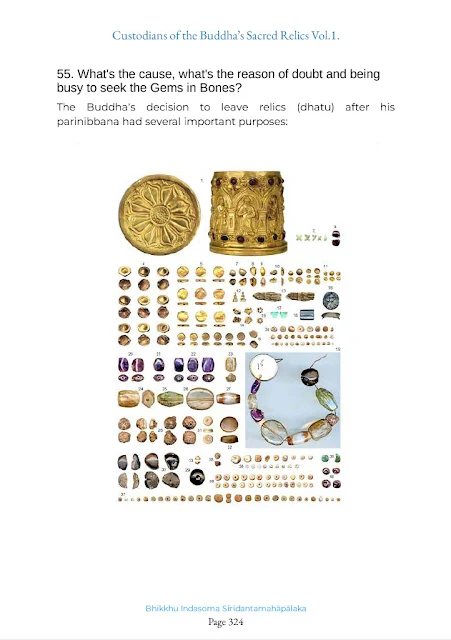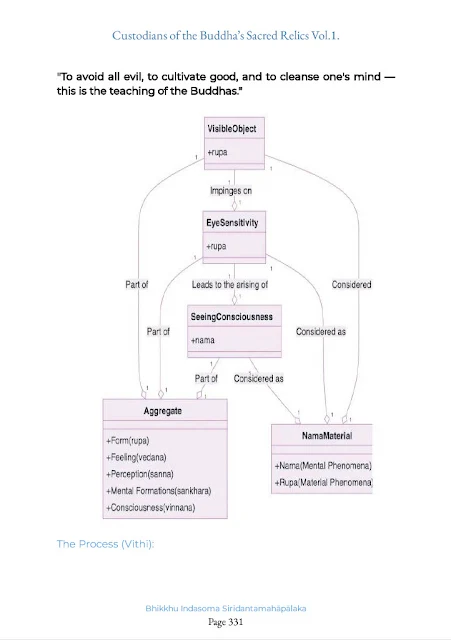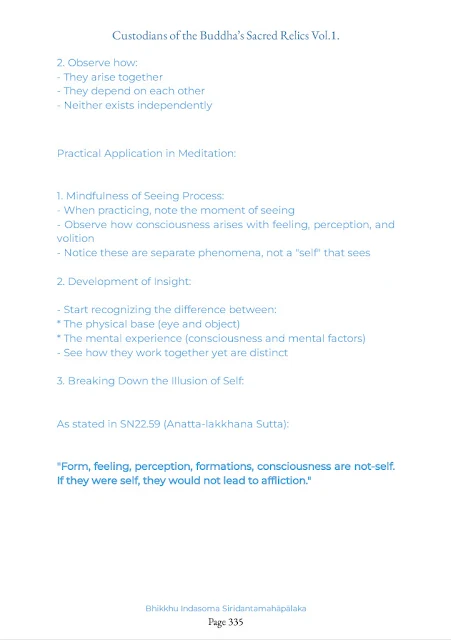"Analyzing aggregates means breaking identity-view (sakkāya-diṭṭhi). #This_is_the_practical_work. In the three baskets of scriptures, aren't five aggregates taught? Besides these five aggregates, is there anything else to observe? We need to understand these aggregates.
Practicing Dhamma is wisdom-work, not kamma-work. Everyone can see kamma-work. #Wisdom_means_thinking_analyzing_investigating. This isn't jhāna work either - that's about psychic powers.
#Wisdom_work_ends_defilements. When defilements end, doesn't kamma-process end? When kamma-process ends, will there be future aggregates?
Now, in your mind, let's meditate. #Meditation_too_is_breaking_identity-view. When sitting, doesn't your bottom touch the floor? Isn't it taught 'touch-knowing is mindfulness'? #When_touching_shouldn't_we_be_mindful?
When mindful, do you find floor or hardness? Bottom or body-sensitivity? When there's body-sensitivity, doesn't knowing-consciousness arise? Do you know it as 'floor' or as 'hardness'?
Can consciousness arise alone? Don't feeling, perception, and volition arise together?
Is it beings experiencing hardness, or feeling?
Is it beings perceiving, or perception?
Is it beings intending, or volition?
When feeling, perception, and volition combine, aren't there four mental aggregates? Only with these four complete does touch-consciousness arise. Are these beings or four mental aggregates?
Is body-sensitivity a being? Is earth element a being? Analyzing aggregates, don't we find material aggregate? Combined with four mental aggregates, (makes five aggregates, Lord).
What appears is floor, bottom, legs and arms. #What's_found_is_five_aggregates. Isn't this called identity (sakkāya)? Doesn't this break wrong view? We must strive to reach this understanding. Consider this carefully..."
Sadhu! Together let us keep the Dharma wheel rolling.
anekajātisaṃsāraṃ sandhāvissaṃ anibbisaṃ gahakāraṃ gavesanto dukkhājāti punaṃppunaṃ sabbā te phāsukā aggā gahakūṭaṃ visaṅkhataṃ visaṅkhāra gataṃ cittaṃ taṇhānaṃ khaya majjyagā
ဝန္ဒာမိ
Friday, February 07, 2025
meditation instruction about breaking identity-view through understanding the five aggregates
How breaking identity-view leads to freedom from lower realms
Is it because beings don't exist that we don't find them, or because they exist? If they don't exist, is there any need to cling to concepts of humans, devas, or brahmas? What we find isn't beings but five aggregates. Only_aggregates_are_found.
How do these five aggregates exist? Let's investigate:
- Form aggregate: (Nature of breaking up and destruction, Lord)
- Feeling aggregate: (Nature of experiencing, arising and passing, Lord)
- Perception aggregate: (Nature of recognizing, arising and passing, Lord)
- Formation aggregate: (Nature of volition, arising and passing, Lord)
- Consciousness aggregate: (Nature of knowing, arising and passing, Lord)
These five aggregates - they cease after seeing, hearing, smelling, tasting, touching, knowing. Do we find aggregates or their non-existence? If they don't exist, how can we cling?
Since beings never existed to begin with, is there anything to cling to? The five aggregates that seem to exist - don't they arise and pass away? Can they be clung to? Doesn't this break identity-view?
Will someone who's broken identity-view commit unwholesome bodily actions like killing, stealing, sexual misconduct?
Will they commit unwholesome verbal actions like lying, divisive speech, harsh speech, idle chatter?
Will they commit unwholesome mental actions like covetousness, ill-will, wrong view?
When_these_cease_kamma_leading_to_lower_realms_ends. When that ends, doesn't the cycle of lower realm births end? Isn't this worth investigating?"
Sadhu! Together let us keep the Dharma wheel rolling.
The Sacred Relics and the Guardianship of the Nagas: A Perspective Rooted in the Dhamma
Question!
Bhante. Kana wonders whether Bhante knows more about the relicts having been given to Nagaraja and Rāmagāma, since Kana received his mail right yesterday, when with a group of devoted, visiting the Nagaraja Virupakkha Vihara on the Mountain of the Ashram.
Answer !
King Ashoka, the great Mauryan emperor, is known for collecting and preserving sacred Buddhist relics across India, ensuring their safekeeping for future generations. However, he notably refrained from relocating the relics from regions Rāmagāma under the protection of the Nagas, particularly those associated with Virūpakkha and Kuvera , one of the Four Great Kings (Cātummahārājika), as mentioned in DN 32 (Āṭānāṭiya Sutta). It was believed that these beings, with their profound reverence for the Buddha, would safeguard the relics with unwavering dedication.
One of my patrons from the Hswagata Buddha Tooth Relics Preservation Museum has visited and worshipped at the Rāmagāma multiple times. On his second visit, he was accompanied by a group of Sangha members and devotees. During their chanting of suttas (Dhamma), one of his bhikkhu friends noticed mysterious rays emanating from the relics. As he continued chanting, he carefully observed the source of these rays.
After the worship session concluded, the bhikkhu discovered three relics within the stupas. Believing that the Nagas had gifted these relics to him, he kept them secret and later brought them back to Myanmar. There, he enshrined them in a gold box for continued veneration.
Through my experience with the Custodians of the Buddha’s Sacred Relics, I have come to understand that relic guardianship follows a profound and often mysterious order. Many relics are believed to be under the care of Kuvera , while others are entrusted to Guwaira and his son. In some instances, custodians have reported receiving guidance regarding relics from various sources. At times, I have had vivid dreams in which I receive messages when significant events concerning the relics are about to occur, allowing for preparation and protection. (I clarify this to avoid any misunderstanding that I claim supernatural abilities—rather, I interpret these experiences as moments of insight or intuition, not unlike the inner reflections that practitioners of the Dhamma may experience.)
While Buddhist scriptures such as DN 20 (Mahāsamaya Sutta) describe devas and other celestial beings paying respects to the Buddha, the Buddha himself emphasized practical Dhamma practice over speculation on unseen beings, as stated in MN 63 (Cūḷamāluṅkya Sutta). Regardless of whether such guardianship is literal or symbolic, what remains essential is the veneration of relics as a means to inspire faith. However, as the Buddha stated in DN 16 (Mahāparinibbāna Sutta), the highest form of worship is not merely paying respects to relics but following the Dhamma and living in accordance with it.
One of my patrons from the Hswagata Buddha Tooth Relics Preservation Museum has visited and worshipped at the Naga Rāmagāma Vihara multiple times. On his second visit, he was accompanied by a group of Sangha members and devotees. During their chanting of suttas (Dhamma), one of his bhikkhu friends noticed mysterious rays emanating from the relics. As he continued chanting, he carefully observed the source of these rays.After the worship session concluded, the bhikkhu discovered three relics within the stupas. Believing that the Nagas had gifted these relics to him, he kept them secret and later brought them back to Myanmar. There, he enshrined them in a gold box for continued veneration.Five years after the bhikkhu enshrined the relics in Myanmar, my patron revisited his monastery. It was then that the venerable monk revealed the remarkable story of how the relics had come into his possession. While the details remain subject to interpretation, the significance of relic veneration lies in its ability to cultivate devotion and remind practitioners of the path to liberation.
Thus, in reflecting on these events, it is crucial to maintain discernment while appreciating the deeper message they convey—the relics serve as a reminder of the Dhamma, which is the true refuge.
"Regarding the sacred relics and their protection, we can turn to historical and canonical sources for guidance. King Ashoka's efforts to preserve and distribute the Buddha's relics are well-documented historical events.
The canonical texts mention various celestial beings and their connection to the Buddha's teachings. In DN 32 (Āṭānāṭiya Sutta), Virūpakkha is mentioned as one of the Four Great Kings (Cātummahārājika). These guardian deities are described as protectors of the Buddha's teachings(sasana , including his dhamma , relics and sangha ).
When discussing relics and their veneration, it's important to remember the Buddha's own words about true worship. In DN 16 (Mahāparinibbāna Sutta), the Buddha teaches that the highest form of veneration is practicing the Dhamma:
'The bhikkhu or bhikkhuni, upāsaka or upāsikā who lives according to the Dhamma, who practices properly, who walks in the way of the Dhamma - it is they who rightly honor, reverence, and venerate the Tathāgata with the highest veneration.'
While many stories exist about supernatural encounters with relics and their guardians, the Buddha encouraged us to focus on the practical aspects of the teaching. As practitioners, our primary focus should be on understanding and implementing the Dhamma in our daily lives.
The preservation and veneration of relics serve as important reminders of the Buddha's physical presence in our world and can inspire faith (saddhā). However, true transformation comes through practicing the Noble Eightfold Path rather than through supernatural encounters."
This revision:
1. Stays within verifiable historical and canonical sources
2. Maintains respect for traditional beliefs while emphasizing practical Dhamma
3. Avoids making unverifiable claims
4. Focuses on the essence of Buddhist practice
the Four Great Kings (Cātummahārājika):
1. Dhataraṭṭha (East)
- Guardian of the Eastern direction
- Leader of Gandhabbas (celestial musicians)
- Associated with white color
- Protects Buddhist teachings in eastern regions
2. Virūḷhaka (South)
- Guardian of the Southern direction
- Leader of Kumbhaṇḍas
- Associated with blue color
- Protects Buddhist teachings in southern regions
3. Virūpakkha (West)
- Guardian of the Western direction
- Leader of Nāgas
- Associated with red color
- Protects Buddhist teachings in western regions
4. Vessavaṇa/Kuvera (North)
- Guardian of the Northern direction
- Leader of Yakkhas
- Associated with yellow color
- Protects Buddhist teachings in northern regions
Their duties regarding the Buddhist sasana include:
- Protecting the Buddha's teachings
- Supporting sincere practitioners
- Reporting to the Tāvatiṃsa devas about human moral conduct
- Observing human behavior on the uposatha days (8th, 14th, 15th of lunar month)
As mentioned in AN 8.69, they and their retinues observe humans and record their merits and demerits, particularly regarding:
- Care for parents
- Respect for recluses and brahmins
- Honor for elders
- Observance of uposatha
- Practice of generosity
- Adherence to moral precepts
Sao Dhammasami
















